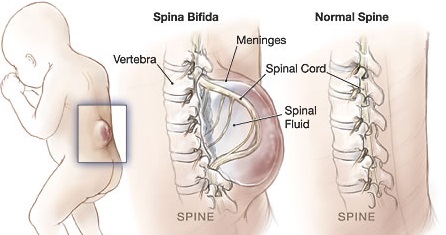In order to find out the spina bifida life expectancy, we first should know what spina bifida is. Spina bifida refers to birth defects associated with the neural tube, the embryonic structure that later develops into the baby's spinal cord, brain, and the tissues that enclose them. The neural tube develops during early pregnancy and closes at about 28thday of conception. If your baby has spina bifida, it means there is some issue related to the development or closure of the neural tube. This causes defects in the bones of the spine and in the spinal cord itself. Keep reading to learn more about this condition.
What's Spina Bifida Life Expectancy?
The life expectancy of spina bifida varies and most people believe that a baby with spina bifida cannot live through childhood. Actually, with the mildest form of spina bifida and no other birth defect, a baby has 70% chances to reach their early childhood.
It is possible to improve life expectancy if steps are taken to control pressure sores, bladder infections, and conditions like hydrocephalus. With a better supply of antibiotics and shunts available, there has been a considerable improvement in spina bifida life expectancy. In 2001, there are statistics showing that up to 75% of children with the severest form of spina bifida lived until early childhood and even longer, but they did require serious support to survive in their adulthood. Some medical professionals believe that about 90% of sufferers can live past 35 years of age.

What Affects Spina Bifida Life Expectancy?
It is important to understand that spina bifida does not always cause serious symptoms. In fact, the sufferer may only have minor physical disabilities. Several factors can affect the severity of the condition and reduce life expectancy of spina bifida. Here is more about it:
The Severity of Condition
The location and size of the neural tube defect may affect the severity of the situation. Other things like if skin covers the affected area or which spinal nerve comes out of the affected area will also determine the severity of your condition. With your condition becoming severe, there will be a considerable decrease in life expectancy with spina bifida.
Possible Complications
Certain complications can affect your spina bifida life expectancy, which could include:
- The first complication is physical and neurological problems, such as paralysis of the legs and loss of bladder or bowel control.
- Accumulation of fluid in the brain is another complication, which is quite common in babies born with myelomeningocele.
- Some people may have to deal with meningitis, which refers to the infection in the tissues around the brain.
- Some children may also develop learning disabilities, have trouble learning math, and encounter problems with language.
- It is also common for children with spina bifida to experience skin problems, latex allergies, gastrointestinal disorders, urinary tract infections and depression.
How to Improve Spina Bifida Life Expectancy
Certain things will help improve life expectancy of spina bifida patients. Here is more about it:
1. Prenatal Surgery
The procedure takes place before the birth of a baby with spina bifida. It takes place before the 26th week of pregnancy and involves repairing the baby's spinal cord inside the uterus. Experts believe that it is better to repair spina bifida defects during pregnancy because nerve function becomes worse rapidly after birth.
2. C-Section Birth
It sometimes becomes essential to go for cesarean birth if a baby has spina bifida. It is mainly because babies with this disorder may be in a feet-first position. Your doctor will recommend cesarean birth if they find your baby in a breech position or detect a large cyst.
3. Surgery After Birth
If a patient has developed meningocele, surgery is the only option available to put the meninges back in place. It is important to go for a surgery early to prevent infections.
4. Ongoing Care
- Surgery is only to repair the damage not the cure for this condition. So babies with myelomeningocele need ongoing care from physicians, surgeons and therapists due to irreparable nerve damage.
- Bladder and bowel problems also need careful attention and a therapist usually works with babies to help them do exercises that would make it easier for them to walk with crutches or braces when they are older.
- There may be other complications requiring additional surgeries. For example, additional surgical procedures are required to correct issues such as a tethered spinal cord.
5. Tips for Home Care
While taking above mentioned steps will help improve spina bifida life expectancy, you need to take some home care measures to make things better. Here are some ways to support your child:
- Never miss any scheduled doctor visits.
- Assist your child and help them be active and as independent as possible.
- Give your child plenty of fluids and encourage them to eat food rich in fiber to prevent constipation.
- Regularly check the skin of your child for any bruises, cuts and pressure sores, especially for children who have no feelings in their legs. Any cuts may lead to an infection.
- Take your child to an eye specialist after regular intervals because spina bifida can weaken eye muscles.
- Never expose your child to latex products if they have a latex allergy.
Talk to your doctor and your child's teacher if you notice any learning difficulties. Also, inform them about your child's condition and ask for any special programs they have available for children with special needs.
